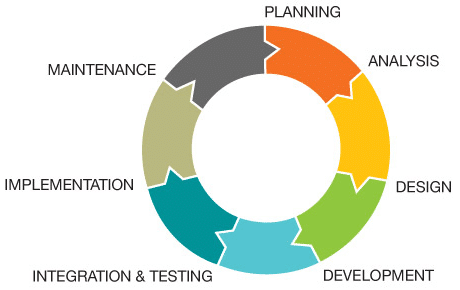Table of Contents
Implementation of smart software solutions is needed for all modern business industries. Most business owners want to make the workflow more efficient and the company more profitable. As any business area is not stable, it is always changing, the software should be flexible, scalable, easy to use, and maintain. Successful integration of software solutions is possible only with clear goals that should be reached with the implementation of software and an accurate plan on how to make it a reality.
What is SDLC?
Software development life cycle or SDLC is the process of a clear definition of goals and stages of building a software solution. It includes several main steps:
- defining the problems
- specifications
- design
- development and coding
- testing
- deployment
- maintenance
The crucial reason for going through all stages of SDLC is to meet all customers` demands and expectations taking into account timing and initial estimation of the project. Developing any custom software solution requires not only a strong technical part. Each customer should be kept up to date about new stages of the development, change, or updates. That’s why communication is not a less crucial part of building the software as a tech stack choice.
Why SDLC is important?
Before the start of the development, the customer and the team of developers need to define the main tasks and structure them into a logical sequence. SDLC helps to make it easier and more organized due to its simple stages that contain particular tasks. Among the main benefits, consider all steps of SDLC:
- providing clarity for customers about the development flow
- tracking all tasks and deadlines
- accurate forecasts for delivery
- help to be within the framework of the budget
- strict following of all customers` requirements
Software Development Life Cycle is an inevitable and useful set of rules that helps to release holistic and multifunctional software that meets all customers` demands and transforms their ideas into tasks. It is also a guidebook for tech and non-tech members of the developer team. All in all, SDLC manages everyone who is involved in the development process, s
How SDLC works?
Software development life cycle improves the efficiency and quality of services by organizing the workflow and following its stages. It also helps to reduce or eliminate unnecessary costs and stay within the budget. Check the video to know more details about the software development life cycle and how it functions.
Software development steps
Planning
No project can start and develop successfully without a care plan. All solution`s aims, objectives, and risks should be carefully defined and structured considering any details or potential problems that can appear during the process. Of course, it is impossible to think of all of them, but an experienced Business Analyst will analyse a particular business area and determine the main risks. Planning is the initial step of each SDLC that helps to reveal the main difficulties that will be resolved with software and create tasks to reach the goals. This stage also defines the ways of the development that will meet all business demands, taking into account time, budget, number of specialists, etc.
Initiatives, Epics, and User Stories
At this stage, it is important to gather all information and business requirements from business owners to see the entire picture. This task is the responsibility of a Business Analyst, and it can be performed perfectly only by constant close communication with customers. All business needs and demands will be later transformed into tasks for developers. After defining the core requirements of the software solution, the specialists create a plan of necessary functions that should be implemented to meet all the demands. All objectives are split into three parts of the development – initiatives, epics, and user story.
The initiative group is the biggest one and includes epics and user stories. Epics are a smaller part of the development that goes after initiative. It usually includes the main functions of the development, a kind of a filling of a solution. The user story contains detailed information about functionality, it is a specific and exact task within the epic. This stage also implies MVP estimation of your product considering the work hours of each developer.
Development stage
Through this stage, a team having a full understanding of requirements and tasks utilizes the most relevant technologies, frameworks, and programming languages to build the product. Developers encounter bugs and various issues along the full process and conduct code reviews, achieving clear app code.
Design
This phase of software development implies the creation of the concept for a solution. During this stage, customers can see the whole structure and a final prototype of their developments. It means that all documents should be gathered, and all tasks should be assigned to the responsible developers. This is the last phase before the actual start of development.

Coding
This development is clear as it is all about writing code and covert epics and user stories into the actual software. This stage of SDLC is considered to be the longest one, and it demands scrupulous attention to every single detail. The code has to match all software requirements and specifications that were defined before.
Testing
The testing stage gets the highest rank of responsibility and necessity after the planning phase. As the software solution is built, it has to be tested by QA engineers to reveal any bug or error during the usage of a solution. There are different types of testing and ways of performing this stage. Usually, QAs perform a set of tests that include testing of functionality, system integration, interoperability, user acceptance, etc. After verification and validation of the software solution, it can be released or implemented.
Deployment
This is the final stage of the development – release or integration of the ready solution. The implementation process also has a plan that is written during the planning phase. After finishing all stages successfully, the software moves to production depending on the complexity of the development. The straightforward release is for a simple solution, staggered release means production in stages if the solution is complex. And now, the solution is ready to be tried by end-users.
Maintenance
Production of the solution is not enough, as it demands constant updates and improvements. It is connected with the feedback of users or needs for changes in the tech part of the solution. The maintenance phase helps to keep your solution ahead of the competitors, add new options, stay modern, and updated in time.
SDLC models
The process of software development and the content of its stages depend on the chosen model of development. We created a list of the most popular models that are used to build a software solution for business.
Agile
This model of software development was not frequently used for projects. however, the situation has changed recently. This methodology is now applied by more businesses for tech and non-tech projects.
The main advantage of Agile methodology is a fast failure option. This model also provides the testing features at each cycle of development and makes it possible to change or improve the performance of the previous stage. These functions give the ability to reveal the smallest failures and fix them before they grow into a huge problem. This model also lets customers be informed of the latest changes in the development process. Agile is a good choice for complex developments as it dilutes and structures the stages for clarity of building.
Lean
The lean model of the software development life cycle follows the principles of lean manufacturing. It includes:
- eliminate waste
- build quality in
- enhance knowledge
- defer commitment
- deliver in the fastest way
- empower people
- optimise the whole
The lean model doesn’t provide multitasking. Efforts of the team are directed to cut waste at each stage of SDLC by reducing time spent on meetings and the number of docs. The main purpose of cutting waste is to get more overall value for customers and provide a great experience of building for them.
Waterfall
This model of software development is considered to be the most common and simple one. The process is straightforward – the next step starts when the team finishes the previous one. Hence the name “waterfall” – when one task falls into the next one according to the plan of each stage. The weak side of this model is that some details are not taken into account, and each stage is not tested separately from the entire project. Consequently, it can cause serious bugs and other problems for the entire solution that can be fixed only at the stage of maintenance.
Iterative
This model SDLC implies a particular set of requirements, performs and tests them, and only then adds all other requirements. It doesn’t cover all objectives from the beginning of the development process. However, it makes the option of changing or adding new functions much easier and less expensive. The weak side of this model is swallowing the resources too quickly.
Spiral
The spiral model of SDLC is considered to be the most flexible one. It is similar to an iterative model of its repetitive character. This model of development includes four main stages:
- planning
- risk analysis
- coding
- estimation
Its spiral nature gives the ability to make improvements during each stage. The spiral model of software development suits huge projects and lets developers build fully customised solutions considering potential risks and trying to avoid them. It also implies the ability to test the solution by users to reveal errors and give feedback.
DevOps
DevOps model of SDLC is a rather new one on the market. It unites developers and operations teams to produce highly qualified and more reliable software with a wide range of functions. It usually emerges two models of software development software – Agile and Lean. It gives the ability to make little updates of the solution on a constant basis, according to the feedback.
DevOps is the combination of cultural philosophies, practices, and tools that increases an organisation’s ability to deliver applications and services at high velocity: evolving and improving products at a faster pace than organisations using traditional software development and infrastructure management processes.
When it comes to the choice of the SDLC model, you, along with the team you hired, need to think carefully and take into account all objectives for the software solution. That is why you should choose the team of developers responsibly and ensure their experience and portfolio.
When do you need a full-cycle development team?
No matter the type and complexity of the software development project, any customer needs a team that will understand the business needs and offer the solutions that will boost your business.
The right full-cycle software development team will be able to join the project at any moment of the project progress, no matter whether you are just shaping your idea or already started the development process.
Altamira team can help you, no matter which tough challenges you are currently facing:
- Start the project from scratch;
- Conduct a discovery phase, helping you to solve a specific business challenge and offer unique solutions;
- Help with the outdated code legacy issues, offering current solution upgrades.
By choosing full-cycle software development, business leaders can observe the full picture of the product development process.
You get the full team
Choosing a full-cycle development company, you hire all the specialists needed to successfully complete and maintain your product, including software engineers, business analytics, UX/UI designers, and QA engineers, who will take care of your product through all stages of development.
Highest quality of the final product
Since full-cycle development always includes testing, bug-fixing, regular code review, and after-deployment maintenance, you will roll out the product of the highest quality.
Flexibility
A customer can introduce changes, improvements, and upgrades through the project progress to achieve one’s business objectives and make the final product fully satisfy the users’ demand.
After-deployment maintenance
A customer gets post-production support. The team of experts monitors the stability of the product operation, quickly fixing possible bugs and ensuring smooth product performance.
Clear view
A customer will have a clear view of all processes, experts involved, estimations, timelines, etc.
Full cycle product software development services at Altamira
Here at Altamira, we have adhered to the Agile software development methodology and managed to achieve flexibility, and fast time to market relying on constant improvement of our technical abilities.
We can gather a professional team of full-cycle development specialists who will effectively work on your product. No matter whether you are starting from scratch or you need a team to join at any stage of product development we will provide you with the highest quality of service.
Services we offer
If you aim to scale your business, we will help you adjust the architecture and provide skilful software engineers to help you with the software development process.
According to the latest NPS results, our customers’ value is for:
- Fast time to market;
- A high level of involvement for the client;
- Direct communication with the project team members;
- Transparency of all processes;
- Flexible cooperation models;
- No hidden costs.
FAQ
The development of software solutions involves the entire team of specialists: Business Analyst, Scrum master, architect or technical lead, frontend and backend developers, QA engineers, and maintenance team.
Each phase of the software development life cycle has its own value. Among the steps that need careful attention are planning, requirements, and testing. Business Analyst will help you to define all business needs and build a plan on how to make them a reality. The testing phase reveals the potential errors in the work of the solution and resolves them at once.
After production, the development of technologies doesn’t stop. The maintenance team helps to track the latest updates and implement them into your solution. It improves the user experience and the level of modernity of your software.



